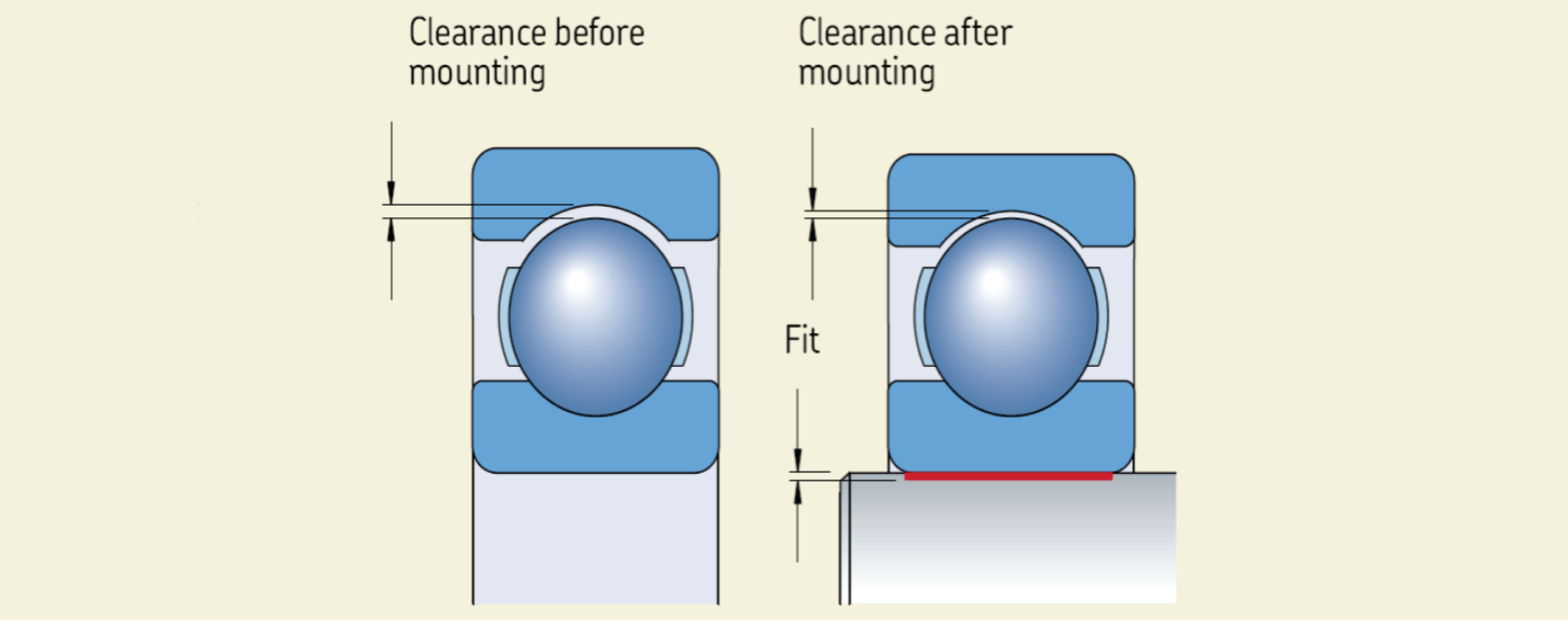Bearing internal clearance is defined as the total distance through which one bearing ring can be moved relative to the other in the radial direction (radial internal clearance) or in the axial direction (axial internal clearance). Among others, single row ball bearings, double row self-aligning ball bearings, single or double row cylindrical roller bearings, spherical roller bearings and CARB bearings all have a defined internal clearance.
The internal clearance is in general identified by a suffix if its range differs from the “normal”, for example, a suffix C3 indicates the next larger internal clearance after “normal” and C4 the next larger range after C3.
There can also be internal clearance lower than “normal” like C2 or C1, though these are less common variants.
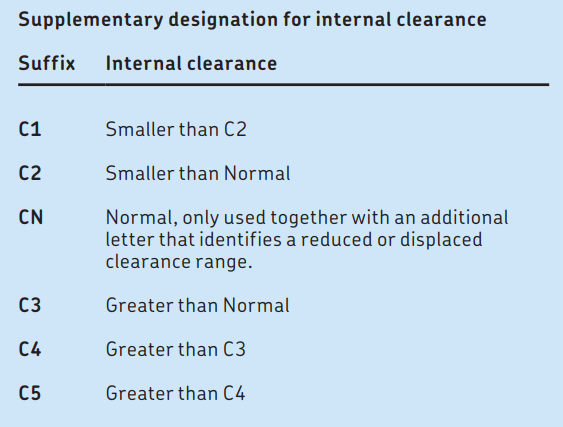
Some bearings have specified radial clearance ranges while others have defined axial clearance ranges which depend on what is the most important for the application depending on the bearing design. For example, single row radial ball bearings like 6309 have defined radial internal clearance, and double row angular contact ball bearings like 3310 have defined axial internal clearance.
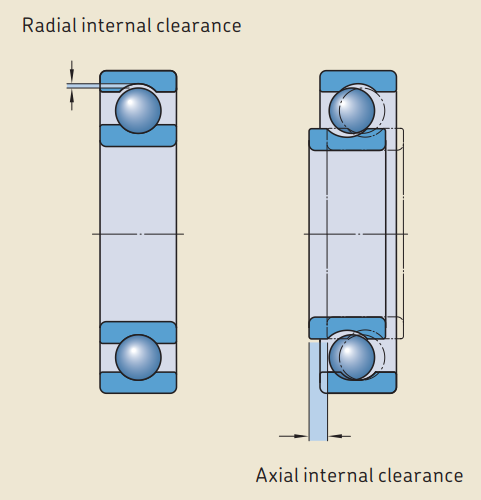
In all cases and depending on the bearing internal geometry, there is a geometrical relationship between these values, or in other words, for a certain radial internal clearance corresponds a certain axial internal clearance and vice versa.
Internal clearance and operating clearance
It is necessary to distinguish between initial internal clearance in the bearing prior to mounting and operating internal clearance, which applies to a bearing in operation that has reached a stable temperature. In almost all applications, the initial clearance in a bearing is greater than its operating clearance. The difference can be attributed to the need for an interference fit on the shaft and/or in the housing, combined with thermal expansion of the bearing rings and associated components.
Sufficient internal clearance in a bearing during operation is extremely important if the bearing is to operate satisfactorily. As a general rule, ball bearings should have an operating clearance (or preload) that is virtually zero. On the other hand, cylindrical, needle, spherical and CARB toroidal roller bearings should always have some residual (radial) clearance – however small – in operation. The same is true for tapered roller and angular contact ball bearings. However, in applications where a high degree of stiffness is required, tapered roller and angular contact ball bearings can be mounted with a certain amount of preload.
What is a "normal" clearance?
The initial internal clearance referred to as “Normal” implies that a suitable operating clearance can be obtained if the recommended shaft and housing fits are realized during mounting and operating conditions are normal. Where operating and mounting conditions differ from normal, for example, when interference fits are used for both bearing rings or considerable temperature differences prevail, bearings with greater or smaller internal clearance than Normal are required.
In these cases, SKF recommends checking residual (radial) clearance in the bearing after it has been mounted.
Factors of operating clearance
The operating clearance or preload in a bearing is determined by:
- the initial internal clearance prior to mounting
- the actual fits
- the effects of form errors
- the internal clearance or preload built into the bearing after mounting
- the dimensional changes resulting from the operating temperature
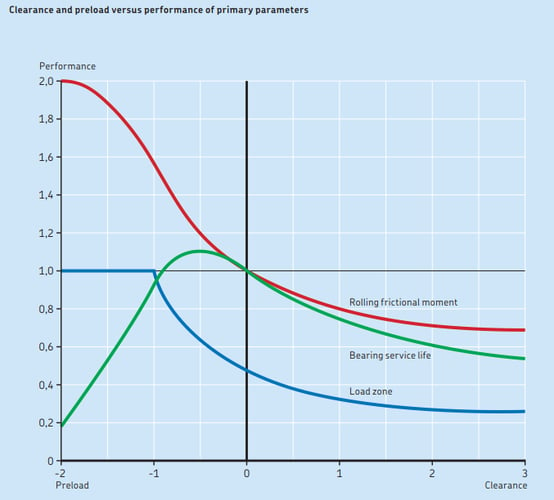
The operating clearance or preload in a bearing influences friction, size of the load zone and fatigue life. The diagram above shows the relationship between clearance and preload, and the primary parameters, based on rolling bearings under radial load.
The changes in existing internal clearance range value: then and now
Existing internal clearance range values for different bearing types were established around 60 years ago. Since then there have been significant improvements in design and manufacturing which are reflected in higher dynamic and static load ratings as well as higher speed values.
If we take as an example the bearing 22220 and compare the 1975 general catalogue (Pub # 3000) with the present rolling bearing catalogue from 2016 (PUB 10000), we can see the following changes:
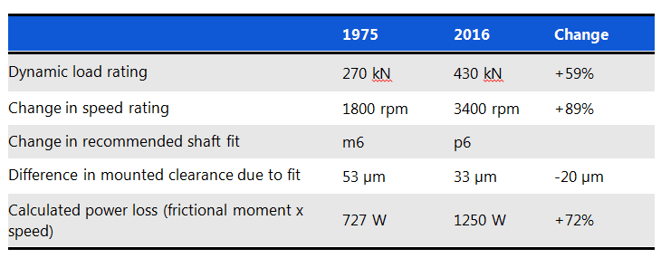
- The dynamic load rating is 59% higher (the bearing can withstand a much higher load than before).
- The speed rating is a staggering 89% higher (the bearing can run much faster).
The speed comparison is made between the lower of the values shown in each catalogue as a one to one comparison is not possible due to the fact that the definitions of speed ratings have changed. - The inner ring has to be mounted with more interference on the shaft, therefore the remaining clearance will be lower. The increased shaft interference is due to the fact that it is proportional to the load applied, and if the bearing is able to withstand higher loads more interference fit is required to avoid creep and fretting corrosion.
How did this change take place?
The above power loss calculation is based on the assumption that we expose the bearing to higher load and speed (they are not calculated at the same load and same speed). For each case the corresponding friction model was used to calculate the total frictional moment, which when combined with the speed results in the total power loss. In simple terms, the power loss is expressing the amount of heat generated by the bearing which is partially dissipated by the shaft, the housing and the air around.
In most applications the housing is larger in mass and has more exposed surfaces than the shaft, which usually means that it has more capacity to dissipate heat (cooling capacity) from the bearing, or in other words the shaft is hotter than the housing. If there is more heat to dissipate (more power loss according to the above table) and considering the difference in cooling capacity mentioned before, we will have a higher temperature difference with today’s bearing higher load capacity and higher speed rating.
The temperature has an impact due the coefficient of thermal expansion that is one basic property of any material. If we make some relatively simple calculation of the thermal expansion in the bearing, and considering the increased temperature difference due to increased power loss, it is easy to understand that the internal clearance of the bearing will be reduced more in the 2016 bearing compared to the 1975 case.
The additional reduction in internal clearance due to the larger temperature difference is estimated to be 18 microns (0,018 mm). When this reduction is combined with the additional clearance reduction due to tighter fit (see table above) we get 18 + 20 microns = 38 microns which for the bearing 22220 corresponds to one full clearance range. Simply, if the bearing from 2016 should have the same operating clearance as the bearing from 1975, when the former is exposed to higher load and speed, we should use C3 instead of normal clearance.
C3 is now the new "normal"
Therefore, we can conclude that in 1975 the bearing was able to run at a certain speed and certain load, and to reach these conditions “normal” clearance was enough. For the same bearing size from 2016, when exposed to higher load and higher speed “normal” clearance is no longer enough and we need to use C3.
Now is probably easier to understand why C3 clearance bearings are much more common these days compared to some decades ago.
Want to understand more about selecting internal clearance or preload?
More details can be found on this SKF webpage here.
SLS is the local authorized distributor and a certified maintenance partner (CMP) of SKF. SLS and SKF go the extra mile to provide reliability services beyond identifying machinery issues and work side by side with you to achieve your maintenance goals.
To find out more about the CMP Program, please click here.

